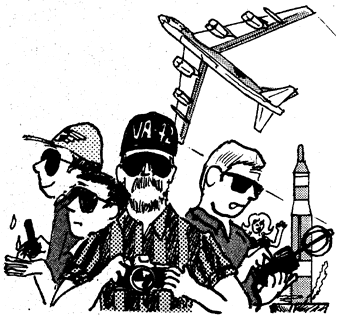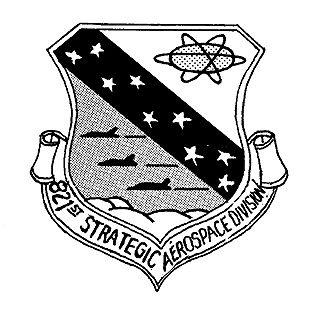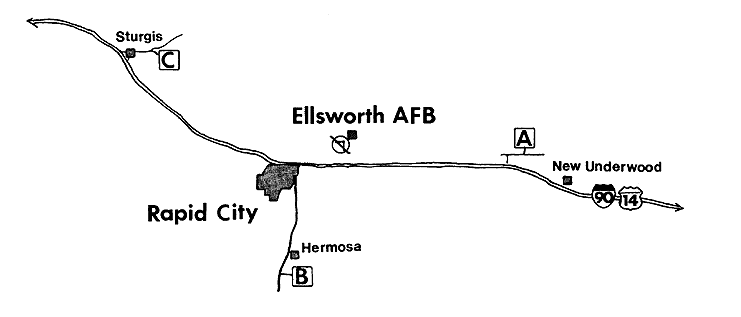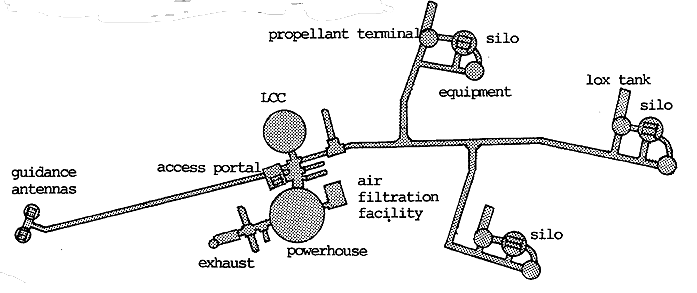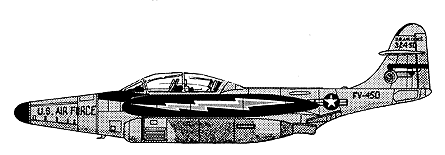E-70 Ellsworth AFB - This one's another easy site to locate, due west of
the AFB on West Nike Road/Meade County 2. The first thing you drive
past as you head up the hill is the housing area, now closed and boarded
up. Continuing up the hill (with a brief stop to allow Tim to let the
residents
know we weren't a truck full of vandals) takes you first to the IFC, and
then the launch area. D/531st and D/2/67th manned the site.
The control area belongs to a church group - has for 19 years - and we were
referred to the pastor, an older gentlemen who told us what he knew
about the site and wanted to know more. The buildings are intact, although
we weren't able to determine the locations for the radars.
Curiously, the missile assembly building - a fixture at any battery site -
was parked
just this side of the gate leading to the launch area. The reverend said
it'd been moved at some point in the past.
Now it gets really strange. According to my records - the ones I used to
put the three Quick Looks and Rings of Supersonic Steel together - E-70 was
an above ground site. Back in '96 1 gazed off in the direction of the
battery area, didn't see anything, and pressed on.
unreproduced image
|
unreproduced image
| |
This time, however, four Turkeys got a good look off to the west ...and saw
a berm, indicating the Ajax fueling area. The padre opened the gate for us,
warned us about snakes, and off we went. We found a NS standard Nike
installation, complete with two magazines and mounting brackets for rails
and six remote launchers (eight launchers total at the site). WTFO...AND,
unlike the other sites, the paved area didn't extend past the front end of
the
silo doors.
There were also a couple of mystery areas, including some paving to the
southwest (former location of the assembly building?). On the drive out,
after we stumbled across three rattlers - Scott and Tim did the honors - we
noted another area, roughly at the 3 o'clock position from the launcher
area; you can barely see it in the photo above. There were four
semicircular concrete pads, each backed by multiple mounting posts and
bolts. The
only explanation we could come up with was this might have earlier served
as a gun site, although the pads are awful close for the emplacement of
multiple Skysweepers. Ah me, looks like it's time to run another "help!"
message on Ed Thelen's web page.
That was it for the day for the four Turkeys, and it was barely
1200...Scott had to get going, so we roared back to the AJ via E-O1C&L
(noting the
newly-laid barb wire at the latter), helped him load out and sent him on
his merry way. As for us three remaining Cold Warriors, well ...we'd debated
driving down to check out the long inactive Black Hills Ordnance Depot,
southwest of Edgemont (I had an ulterior motive; that would've put me
within spitting distance of the ex-CB&Q/current Burlington Northern Santa
Fe mainline out of the Powder River coal country). However, after 2.5
days of intense site surveys and late nights, I think we were all pretty
much out of it.
Instead, Tim agreed to run me down to the former C&NW roundhouse on the
southeast side of Rapid City; in return, I offered a tank a gas, which he
accepted. We made the quick rounds, I got my shots, and then we returned to
the hotel to arrange our trip notes and rest up for the evening's banquet.
Way back when Rapid City hosted two railroads: the Chicago, Milwaukee, St
Paul & Pacific, which came into the city via a line from Sioux Falls and
Chamberlain; and the Chicago & Northwestern, which arrived via lines from
Pierre and the famous "Cowboy Line" across Northern Nebraska. The
Chicago, Burlington & Quincy served the towns of Deadwood and Custer via a
branch from their Crawford, NE to Sheridan, WY, mainline, while the
Rapid City, Black Hills & Western connected Rapid City with a junction on
the CB&Q named Mystic.
Nowadays ops in Rapid City are held by one railroad, the Dakota, Minnesota
& Eastern, which acquired the old C&NW line from southeastern
Minnesota all the way the Colony, WY and south towards Crawford, NE. I'd
managed to shoot some DM&E power on my last trip and had hoped
to do some more serious train chasing on this excursion, but never managed
the time. However, I did have Rick's two previous RAP trip reports, the
spring 1998 issue of The Milwaukee Railroader - covering the MILW's ops in
South Dakota - and a similar article on C&NW operations from the
spring 1997 edition of North West Lines.
C&NW/Rapid City - The Chicago & Northwestern was the first railroad to
reach the Missouri River in South Dakota, arriving at Pierre in 1880.
The company then pushed west to Rapid City and on to Piedmont, Tilford,
Sturgis, Whitewood and Deadwood before stopping in Colony. The lines
in the Deadwood/Lead mining area incorporated both standard and narrow
gauge operations; another branch extended from Whitewood to Belle
Fourche, Fruitdale, Nisland and Newell.
Both major railroads built into the region for the usual reasons: to bring
settlers, help develop an agricultural base, and export the food goods.
Unfortunately, this part of South Dakota isn't prime growing land (cattle,
yes); after the dustbowl of the 1930s, there wasn't much left in the way of
food production and both companies started struggling. As with many branch
and secondary lines around the country, passenger service eventually
ended; the C&NW ran the Dakota 400 into town until about 1953, then shifted
to strictly freight service.
Eventually the company's line through Rapid City became important due to
the presence of bentonite (a drilling mud) production in the vicinities of
Belle Fourche and Colony. By 1983, the C&NW was ready to abandon its line
from Winona, MN west to Rapid City in deference to the Cowboy
Line, but the ICC blocked the bid. The railroad did successfully sell most
of its South Dakota operations in 1986 to LB Foster Company of
Pittsburgh, PA; the "main" from Winona to Rapid City ended up in the hands
of the Dakota, Minnesota & Eastern.
The DM&E still uses the old four-stall brick roundhouse, located on the
south side of town near where SD 79 meets St Joseph Street. At the time of
our quick visit DM&E GP38-3 No.3833, "City of Aurora" (ex-IC 3059/ICG
3059?KCS 7951) was idling in the small engine facility adjacent to the
roundhouse.
At the time of Rick's 1993 visit the C&NW operated out of their yard on the
southeast side of town as well as the roundhouse and engine facility;
after the UP/C&NW merger in 1996, the DM&E gained the remaining C&NW
trackage in town as well as the facilities. The line which once was
an outpost for RSDs, GP7s, GP9s and GP35s now sees primarily GP and SD40s.
At the moment, the DM&E is trying to get approval to punch
through further west into the Powder River coal company, which could turn
the railroad into a major regional player (and probably heighten their
visibility as acquisition bait). However, even in this pickup truck and red
meat part of the country, they're running into environmental opposition
(sure, let's just put more trucks on the road!).
MILW/Rapid City - The Chicago, Milwaukee & St Paul was second railroad to
built into South Dakota, arriving in Chamberlain in 1881. The
company reached in Evarts in 1900, making the town a major cattle shipping
point; in 1906 the CM&StP abandoned the town and moved across the
river to Mobridge, using it as the jumping off point for its Pacific
Extension to Puget Sound.
Seventy-four years later, in 1980, the MILW abandoned its lines west of
Mobridge; the move affected more than half of South Dakota's total railroad
mileage, much to the consternation of the state's government and local
farmers and ranchers. In 1981 Governor Bill Janklow dragged the legislature
into session and it agreed to purchase most of the company's trackage in
the state; the state then leased large portions to the Burlington Northern,
in
particular the line to Miles City, MT. In March 1982 the MILW abandoned all
of its trackage west of Ortonville, MN; the state of South Dakota
responded by buying the entire mainline from Ortonville to Miles City.
Along the southern portion of the state, the Dakota Southern operates from
Mitchell through Chamberlain to Kadoka; from Kadoka west, the railroad
is abandoned and will probably become a trail. The rails are still in place
at some points in the vicinity of Rapid City, but other than the two
structures remaining downtown, there's not much left to remind people of
the Milwaukee Road.
Fortunately, both the passenger and freight depots are preserved and in use
as restaurants. I mentioned the freight house earlier; when brother Rick
came through in 1993 a business used it for storage, but now it's
Sanford's. The pax station is immediately next door and is now La Costa
Mexican
Restaurant. Externally it's in great shape and I expect the inside is also
in good condition.
According to Rick, the Milwaukee Road suspended regular passenger train
service to Rapid City during the 1940s and ran a mixed train into the
1950s. After that, nada.
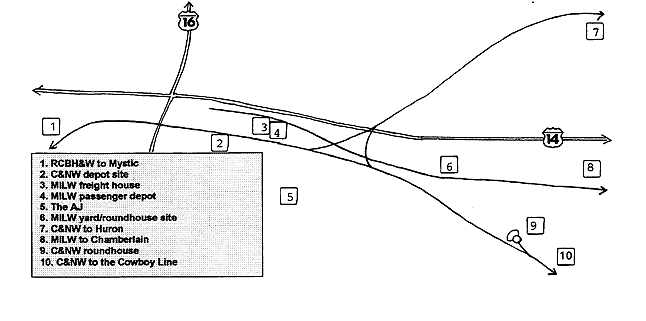
On the way back to the hotel Tim was kind enough to stop while I got a shot
of a DM&E train coming off the Pierre line and heading for the yard
(thank you Tim!). In the lead were SD40-3s 6071 (ex-CPR 5520, in Soo red)
and 6072, "City of Pierre" (ex-CPR 5537).
Later I made a quick walking tour of downtown, getting photos of the Elks
Theater (part of the 1911 Elks Building, natch), the two depots and a
couple of grain elevators, grabbed a quick burger at Hardees' (hmm...from
the logos and the menu it's apparent Carl's Jr. bought them out; there goes
another good Southern company) then headed back to the AJ to rest up, clean
up and put on my Class As for the evening banquet. That night the
CAMP faithful enjoyed a good meal, good company, and a speech by Brig. Gen.
Edwin H. Simmons, USMC (Ret), Guadalcanal combat veteran,
Korean War Veteran, author (Dog Company Six, released last year by the U.S.
Naval Institute), a former president of CAMP and the Director
Emeritus of Marine Corps History and Museums. Neat guy (for a general);
gave a good talk and everyone had a good time.
Phew ...hate to say it, but it was time to pack and get some sleep. I made
a quick visit to the admin room on the ninth floor (absolutely nothing like
the ones I'm familiar with, but hey, it's a different crowd), stayed up too
late watching the tube, and finally hit the rack about 0030.
Sun 13 May 01
Which proved to be something of a major mistake, as Ron Plante made a
courteous and prompt wakeup call at 0520 (followed by Tim's call, about 10
minutes later... "GET OUT OF BED!"). Sigh ...with friends such as these...
Tim dropped us off at RAP about 0630 then headed off on his own adventure,
a winding trip back to greater Detroit (actually, he lives in no-kidding-
by-God downtown Detroit); Ron and I caught our plane, BAe-146-200A N156TR,
he slept most of the way to DEN, and after about a 40 minute
layover there I boarded B757-222 N559UA (oh the humanity) the and wedged
into my window seat for the relatively short flight back to SEA Mom
picked me up at the airport, I drove us home, and the following day took
her back to SeaTac for her flight to Crofton, MD and my nephew Bryan's
graduation.
Regrets? Overall, I only had a few ...I would've liked to get in more rail
action, particularly DM&E freights on the fly or BNSF coal train ops down
by Edgewood (this is the point where Ron, Tim and Scott grab their copies
of this TR, wave them in the air and yell, "NO! NO! ANYTHING BUT
THAT!"). I did manage a fair amount of shots in downtown Rapid City, but it
would've been nice to get out and do more motels and the like.
But overall? One hell of a trip, in great company (what's that old Royal
Navy saying? "In Gallant Company?" I don't know if we were gallant, but we
sure managed to have fun). I'd do it again in a heartbeat, with any and all
Turkeys (Michael, you've got to join us next time we do something like
this).
Addenda: Homeward Bound
Scott was first to head back to homeplate, departing for Texas on Saturday
and saying something about "Schilling AFB," Atlas F and Titan 11. As
for Tim, once he dropped the Roninator and me at the airport he started
back for Detroit via the Blue Scout Junior sites of eastern Nebraska and the
SAC Museum. Scott made it as far as Wisner, SD, the first night; Tim
managed to hit Pickstown AFS on his first evening, where he confirmed the
casino I visited in August 1996 was the old air force station site.
For the record, Tim checked in Wednesday afternoon saying he'd successfully
reached his home high above the Detroit River about 1000L...having
put 3709 miles on his GM. Enroute he hit locations like Grand Island AAF,
Lincoln AFB WSA, Offutt BF Transmit Annex at Elkhorn, NE, and the
Atlas D site at Arlington, NE.
As for Bon Homme Scott, he notched Kearney, Schilling and McConnell AFBs, a
mix of Atlas F, Atlas E and Titan II silos, AND successfully
located SC-50L, the never operational Nike Hercules site on the south side
of Schilling which I wasn't able to find back in 1990.
Now ...to figure out a way to get back to the KS/MO area so I can see all
these neat places ....In the meantime, we most definitely have to do this
again!
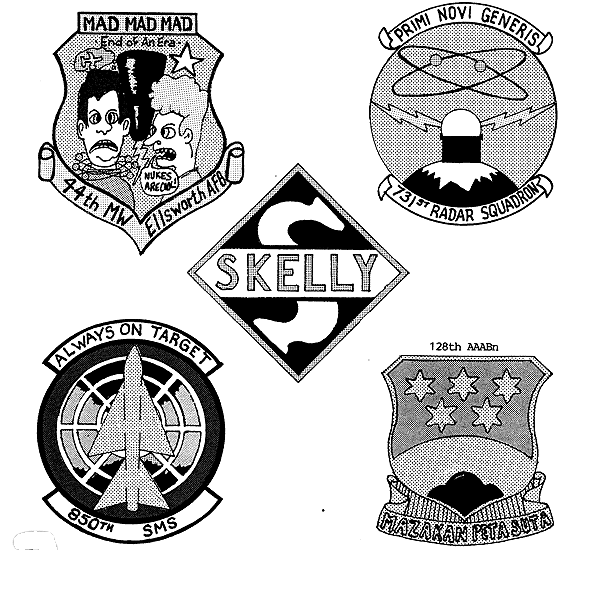
Back to Trip Reports
